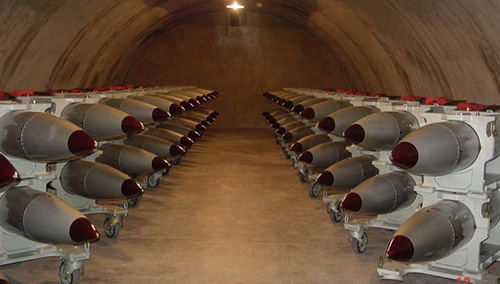"The American response to counter the new Russian course (supported by last generation systems) will be: the problem is that we are still evaluating what needs to be done between budget cuts and bureaucracy".
In the last report of the Department of Defense to Congress, the military demanded a higher budget for the 2017 "aimed at ensuring that significant military advantage we still have over Russia". Gap that is thinning, but still present.
Among the main problems, the violation of the nuclear non-proliferation treaties that, according to the USA, would by now be evident and that represent a "serious threat". The USA, among other things, fear the entry into service of the new Russian systems: from the "Status-6" atomic torpedo to the intercontinental ballistic missiles Bulava, Topol-M e yars.
What scares NATO the most is that the Russians possess intermediate-range missiles on warships, as demonstrated several times during attacks against Islamic State positions in Syria. Translated means that from the Caspian Sea, NATO countries could be affected in the event of military escalation directly from the sea with conventional and non-conventional warheads.
It should be noted that the United States announced last year that Russia would be in violation of the "Intermediate-Range Nuclear Forces (INF) Treaty" signed in the 1987, which forbade the Soviet Union and the United States to deploy intermediate-range ballistic missiles and nuclear and conventional cruise ships launched from the ground. Although the issue with Moscow was raised in the 2013, the non-compliance would go back to the 2008. The United States has invested one billion dollars in the 2015 to support the rotation forces in the Baltic States and Central Europe with tanks, artillery, infantry, combat vehicles and other equipment located in the Baltic States and in Bulgaria, Romania and Poland .
Pending the modernization of the entire nuclear arsenal (already in place), and of all the programs in development, the short-term answer already has a name: the B61-12 nuclear bomb carried by the F-35. The 180 tested B61 located in the six bases in Europe, will be converted to the Mod-12 version within the next three years (funds already allocated). The B61-12 with an accuracy of 30 meters from the lens requires only one tested by 50 kilotons (a more acceptable power and with fewer side effects). This means more accuracy and a new use on the battlefield. The detonating efficiency of a head from 50 kilotons, within a radius of 30-68 meters, is absolutely necessary to pulverize any type of fortified bunker. The B61 technology is also known as "Dial-a-yield". This means that every bomb has an adjustable power: from a maximum equivalent of 50.000 tons of TNT to a minimum of 300. The use on the battlefield, therefore, can be customized depending on the desired effect and the objective.
The upgrades, despite the postponements and cuts, will be completed by the end of the 2018, on pain of the deterioration of the more obsolete titles (ie those located in Europe) for a total of 500 tested Mod-3, 4, 7 and 10 to be converted. With the new modifications, the bombs can be used more "easily" by the commanders in the field. While not technically a new weapon, the Pentagon update transforms the current "stupid" (that is, free-fall) nuclear inventory into "intelligent", into a weapon system, that is, a precision-guided one. It should be noted that precisely in Europe, the B-61-12 can be transported exclusively by the F-35. F-16 e Tornado, in fact, due to some incompatibilities between the systems, they could not launch the new Mod-12.
 The update of the 500 nuclear warheads should also be seen under a tactical profile. Starting with the 2020, NATO could have a low-observability fifth-generation fighter (the F-35) equipped with intelligent nuclear weaponry with scalable power. The true g which could stabilize the European asset is therefore the B61-12 bomb. The cost of updating the first stock from 500 bombs B61, considered a real program of life extension of the system, it will cost American tax payers from 8 to 12 billions of dollars. They will remain in service until 2040. The B-61 represent a nuclear deterrent considered able to dissuade even the allies themselves from developing "homemade" nuclear weapons. But the Americans plan to integrate the B61-12 also on the aircraft carriers, reviving the concept of "double capacity".
The update of the 500 nuclear warheads should also be seen under a tactical profile. Starting with the 2020, NATO could have a low-observability fifth-generation fighter (the F-35) equipped with intelligent nuclear weaponry with scalable power. The true g which could stabilize the European asset is therefore the B61-12 bomb. The cost of updating the first stock from 500 bombs B61, considered a real program of life extension of the system, it will cost American tax payers from 8 to 12 billions of dollars. They will remain in service until 2040. The B-61 represent a nuclear deterrent considered able to dissuade even the allies themselves from developing "homemade" nuclear weapons. But the Americans plan to integrate the B61-12 also on the aircraft carriers, reviving the concept of "double capacity".
The US government, to date, envisages the possibility of equipping land-based F-35As with nuclear weapons, but even the F-35C could receive the same capabilities as a "visible manifestation of the United States' commitment to protecting its own "allies.
According to 'The Atom Project' "America needs several nuclear weapons: from low-yielding ones to tactical nuclear weapons up to weapons of mass destruction".
(photo: Lockheed Martin / web)












